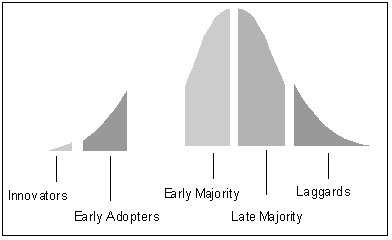What is "Emerging" Information Technology?
What is Emerging?

Figure 1 - G. Moore's Adoption Curve1
|
|
Innovators and Early Adopters: people willing to invest the time
required to adapt a core technology to their needs.
Early Majority, Late Majority, and Laggards: people who need
"whole products"—the core technology plus accompanying support materials such as
documentation, validation data, installation instructions, tailoring
instructions, and customer support.
Characteristics of Innovators and Early Adopters
Venturesomeness: the willingness and desire to be daring in
trying something new and different
Social integration: frequent and extensive contact with others in
one’s area
Cosmopolitan: point of view extending beyond the immediate
neighborhood or community
Social mobility: upward movement on the social scale
Privilegedness: attitude and possession of money (less risky to try
something new) |
What is technology? What is
information?
How long does it take information
technology to "emerge"? What is the catalyst?
- Windows (Xerox Star 1975 - MS-Windows 3.0 1993) Intel 80386
- Analog/Digital "Cell" Phone (AT&T 1970s - Cellular One 1980s - Sprint
1990s) below $50/month barrier
- Hand Helds (Sinclair 197? - Palm 7
2000) $300 + e-mail connectivity
- Broadband Home Access
( Excite@Home1998 - ? )
Telecommunications Act of 1996?; $50 barrier?
- Other Examples?
|
| Emerging Information
Technology NOT SAME
AS Successful
Information Technology |
|
Gartner's Hype Cycle
2
Technology Generation Gaps
Senior
|
|---Strategic Knowledge---|---Strategic Knowledge---|---Strate
Mid
| |---Tactical
Knowledge---|---Tactical Knowledge---|---Tactical Knowledge
Lower |---Detail Knowledge---|---Detail Knowledge---|---Detail
Knowledge---|---Detail K
__________________________________________________________________________
1st Generation--->2nd Generation---->3rd Generation---->4th
Generation---->5th Generation --
Technology Generations -------------------------------->
Examples of Emerging IT, Practice Areas and
Management Technique
Information Technology - a system employing processes and people for
more efficient and effective processing of data. A modern definition includes
the use of computing hardware and software.
IT Management Practice Area - a functional area, especially within
large organizations, under the umbrella of the Chief Information Officer.
Examples include Customer Relationship Management (CRM) and Enterprise
Architecture.
Management Technique - a method/process which may be utilized to
make operations more efficient and effective within any functional area of the
organization. There are thousand of examples varying from deep breathing
relaxation to genetic algorithms.
Definitions
Management -
Effectiveness -
Efficiency -
Emerging Information Technology Areas (in early
2004)
Digital Paper, Organic LED, 3D-HUDs, Quantum Computing, Swarm Intelligence,
Audio Mining, Semantic Web, Video Mining, Collaborative Business Intelligence,
JSR170, XML Based Multi-channel Output & Interaction, Content Process Fusion,
Personal Knowledge Networks, Corporate Blogging, XML Appliances
IT Management Practice Areas
CRM, ERP, TCO, Business Intelligence & Data Warehousing, IT Services
& Outsourcing, Web Services, Managing Intellectual Capital, Application
Integration and Middleware, Enterprise Architecture, Enterprise Management
Software, Operating Systems Software, Knowledge Support, Personal Productivity
Software, E-Payments, Application Development (AD) Tools, AD Governance, AD
Methodologies, AD Deployment, Asset Management, IT Performance Measures and
Metrics
Techniques for Improving Management in IT
The Learning Organization, Management By Objective (MBO),
Political Economic Social Technology (PEST) Analysis, Critical Success Factors (CSF),
Balanced Scorecard, The One-Minute Manager, Moments of Truth, Pareto Charts, Affinity
Charts, Spider Diagrams, Force Field Diagrams, Storyboarding, Benchmarking, Control Charts, Six Sigma, Root
Cause Analysis (Goals), Quality Function Deployment (QFD), Total Quality
Management (TQM), House of Quality, Brainstorming, Nominal Group Technique ,
Simulation, Knowledge Management, Expert Systems
1. Crossing the Chasm : Marketing and Selling High-Tech Products to
Mainstream Customers by Geoffrey A. Moore, Regis McKenna Harpers Business,
1991.
2. 2001 Hype Cycle of Emerging Trends and Technologies. Gartner
Group Research Note. 2 July 2001.

